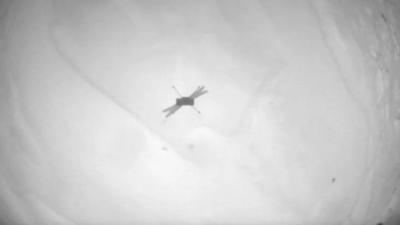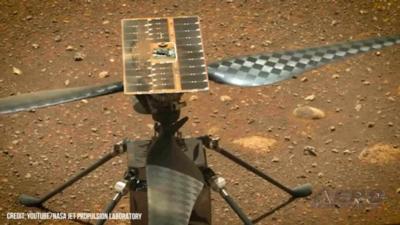Stalwart Rotorcraft Completes 59th Red Planet Flight
NASA's Ingenuity helicopter, while executing a 16 September 2023 sortie, broke its own Martian altitude record, ascending 66-feet above the inhospitable expanse of Mars’s surface. The achievement lent an august air to the contraption’s 59th flight, and evinced the remarkable resilience of a machine now well into its 31st month on the iconic Red Planet.

A representative of NASA’s Jet Propulsion Laboratory set forth in a 19 September X posting: "Ingenuity has set a new record! The #MarsHelicopter successfully completed Flight 59, flying its highest altitude yet—twenty-meters [66 feet]. The rotorcraft was in the air for 142.59 seconds."
Flight 59 comprised a hover exclusively; Ingenuity covered zero horizontal distance. Over the aggregate entirety of its Martian flights, Ingenuity has traveled a total of 43,652 feet (7.18-nautical-miles) and remained aloft for 106.5 minutes (one-hour, 46-minutes, thirty-seconds)—so states the machine’s flight log.
Prior to its 59th flight, Ingenuity’s highest altitude was recorded at 59-feet AGL. To date, the helicopter’s single-flight distance and duration records stand at 2,310-feet and 169.5-seconds—set in April 2022 and August 2021 respectively.
NASA’s diminutive, robotic Ingenuity helicopter was conveyed to the Red Planet slung to the underside of its more famous counterpart, the Perseverance rover. The two machines arrived on Mars 18 February 2021 after a seven-month spaceflight from Florida’s Cape Canaveral.
Ingenuity’s maiden Martian flight—the first extraterrestrial flight undertaken by a human-made aircraft—took place on 19 April 2021. The historic instance saw Ingenuity take-off vertically, hover, and land over a flight duration of 39.1 seconds.

The primary mission about which Perseverance and the Ingenuity have remained for the better part of three-years is the exploration of Mars’s Jezero Crater, a 45-kilometer (diameter) feature of the planet’s Syrtis Major quadrangle. NASA scientists posit the Jezero Crater may once have contained liquid water, and consider the region among the best places on Mars to search for evidence of past life—likely microbial life, but life nonetheless.
In a number of Slavic languages, the word jezero means lake.
While it carries no life-detecting instruments, the Perseverance rover is eminently well-suited to study the geological and chemical characteristics of Mars’s surface.
Since landing on the planet in 2021, the rover has traveled some 17.5 kilometers, all the while studying and collecting samples of Martian regolith.
Ingenuity, conversely, was intended to be little more than a technology demonstrator—a prototype intended to fly only a few times for purpose of vetting component and system architectures. Nevertheless, the intrepid little machine, which comprises a sobering number of smartphone processors, cameras, and other off-the-shelf components, has soldiered on, overcoming time, wear, and even Mars’s ferocious dust storms.

As Ingenuity is a solar-powered craft, dust-buildup on its solar-panels is a particular—and particulate—hazard, as is the weak solar radiation characteristic of the Martian winter.
The resilience demonstrated to date by the Ingenuity helicopter has surprised and delighted the aircraft’s Earthbound controllers. Ingenuity team lead Teddy Tzanetos remarked: “When we first flew, we thought we would be incredibly lucky to eke out five flights.”
Notwithstanding 59 flights and the adulation of its stewards, Ingenuity is manifesting signs of wear and tear. Mr. Tzanetos added: “We have come so far, and we want to go farther; but we have known since the very beginning our time at Mars was limited, and every operational day is a blessing. Whether Ingenuity’s mission ends tomorrow, next week, or months from now is something no one can predict at present. What I can predict is that when it does, we’ll have one heck of a party.”
 Samson Sky Hits the Wind Tunnel
Samson Sky Hits the Wind Tunnel ANN's Daily Aero-Term (05.22.24): LAHSO
ANN's Daily Aero-Term (05.22.24): LAHSO Aero-FAQ: Dave Juwel's Aviation Marketing Stories -- ITBOA BNITBOB
Aero-FAQ: Dave Juwel's Aviation Marketing Stories -- ITBOA BNITBOB ANN's Daily Aero-Linx (05.19.24)
ANN's Daily Aero-Linx (05.19.24) ANN's Daily Aero-Term (05.19.24): Back-Taxi
ANN's Daily Aero-Term (05.19.24): Back-Taxi





